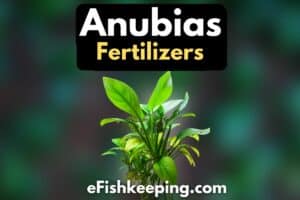Have you noticed holes in your Anubias plant and wondered what could be causing it?
Key Highlights:
- Holes in Anubias leaves can be caused by nutrient deficiency, pest infestation, or snails eating the leaves; proper care and monitoring can prevent these issues.
- Although Anubias plants cannot repair existing holes in their leaves, they can still grow new healthy leaves if the underlying issue is addressed.
- To maintain healthy Anubias plants, ensure proper nutrient levels, control pests and snails, provide appropriate lighting, and plant the rhizome correctly.
In this article, I will explain the possible reasons behind this issue and provide you with some practical solutions to help your Anubias plant recover. So keep reading to clear all your doubts!
Is It Normal For Anubias Leaves To Have Holes?
The development of holes in anubias leaves is a common issue that many aquarists experience with their Anubias. However, it is not normal for healthy plants to have this problem, and it is crucial to take action when you notice such symptoms in the leaves.
Ignoring the problem can result in a worsening condition that could eventually lead to the death of the plant.
Typically, holes in Anubias leaves are caused by a lack of potassium or other important nutrients needed for plant growth.
In some cases, a pest infestation could be the culprit, and failing to address the issue could lead to further problems.
What Causes Holes In Anubias Leaves And What To Do About It?
1. Nutrient Deficiency
CAUSE: A lack of essential nutrients, such as nitrogen, phosphorus, and potassium, can lead to holes in Anubias leaves. These nutrients are vital for the plant’s overall health and growth.
How to identify if your anubias is suffering from potassium deficiency?
- Pinhole formation in the leaves.
- The pinholes have yellow borders around them.
- But other than that, the leaf is normal.
If your anubias leaves are looking yellow or pale, then it won’t be limited to just potassium deficiency and can be many other deficiencies. Usually, yellowing i’s because of iron and nitrogen deficiencies.
I highly recommend you check out this article where I explain Anubias yellowing in detail.
SOLUTION: To combat nutrient deficiency, regularly dose your aquarium with a liquid fertilizer containing essential nutrients.

For regular dosage, I highly suggest checking out the Seachem Flourish – a comprehensive plant fertilizer (available on Amazon) that fulfills the need of trace elements, and micro nutrients that are needed for the plant growth. For instance, it contains magnesium, calcium, iron, potassium, etc.
However, being an all-round fertilizer it may not have specific nutrients in enough quantities. So for treating specific nutrient deficiencies, you can also purchase their specialized fertilizer as follows:
- Flourish Nitrogen (available on Amazon)
- Flourish Potassium (available on Amazon)
Monitor your aquarium’s water parameters to ensure proper nutrient levels and make adjustments as needed.
2. Pest Infestation
CAUSE: Burrowing nematodes are tiny worm-like creatures that can cause damage to Anubias roots and leaves, leading to holes in the leaves.
These worms can invade the leaves and stems of the plant, causing holes and damaging the cells. They also disrupt the flow of nutrients in the plant, which makes it harder for the plant to grow properly. The nematodes can even cause discoloration and small brown spots on the leaves.
SOLUTION:
Microscopic worms called burrowing nematodes may make their home inside the roots and stems of aquatic plants, where they will wreak havoc on the leaves and the plant’s general health. What you can do to fix the problem is as follows:
- The first step in stopping the spread of nematodes is removing and properly disposing of any contaminated leaves or plant matter.
- Nematodes may also be eliminated with the use of heat.
- As an additional line of defense, you can keep your aquarium clean by regularly cleaning the plants and equipment and by not adding any new plants into the system without first quarantining them.
3. Improper Lighting
CAUSE: Insufficient or excessive lighting can cause stress to Anubias plants – leading to issues regarding the overall plant health and the leaves.
SOLUTION: Anubias plants thrive in low to medium light conditions. Ensure your aquarium has the proper lighting for Anubias by:
- As a rule of thumb, Anubias need around 3W of LED lighting per gallon of water in the tank. So you can estimate the lighting based on the general rule.
- Using an adjustable aquarium light to control the intensity and duration of light exposure is a good idea.
Check out my detailed Anubias Lighting Guide for more information on this topic.
4. Not Planted In The Right Way
CAUSE: Anubias plants have a unique root structure called a rhizome. Burying the rhizome in the substrate can cause the plant to rot and lead to all such plant health related issues.
SOLUTION: To plant Anubias properly:
- Attach the rhizome to a piece of driftwood, rock, or other decorations using fishing line or super glue.
- Alternatively, let the rhizome rest on top of the substrate, allowing the roots to anchor themselves in the substrate without burying the rhizome.
5. Snails Eating The Leaves
CAUSE: Some snail species, such as the Malaysian Trumpet Snail, can munch on Anubias leaves, creating holes.
SOLUTION: To deter snails from eating your Anubias leaves:
- Introduce snail predators – such as Assassin Snails or certain fish species like Loaches, to your aquarium.
- Manually remove snails from the aquarium and reduce their population.
- Maintain a well-balanced and clean aquarium to discourage snail infestations.
Can Anubias Recover From Holes In Its Leaves On Its Own?
It depends on how much damage has been done. Usually, aquatic plants can’t repair the holes once they occur. So whatever holes have occurred in the leaves of your anubias, they will remain as it is.
But the good news is if you have treated the anubias, the new leaves will grow healthy and without any holes.
So does that mean you should cut off and trim the old anubias leaves that have holes?
Well, I would say, avoid cutting off the leaves if the plant is sick as it could be perceived as a stress.
That said, if you notice that the whole stem associated with the damaged leaves and all the veins and veinlets associated with the leaves are damaged – then it would be a good decision to cut off the leaves.
Related Read: Will Anubias Survive Without Leaves?
If you ask me, I prefer cutting the damaged leaves off the plants because it allows the plant to focus its energy in growing the new parts rather than spending its energy in already damaged leaves.
In general, old, damaged leaves of a plant won’t regrow, no matter how good the conditions become. This is particularly true when the leaf begins to deteriorate physically, such as with holes or broken leaves.
The plant will instead direct its resources toward new leaf development. Plants constantly grow by adjusting their development to the present circumstances and losing older leaves.
Wrapping Up
In a nutshell, it is crucial to note that holes in the leaves of an Anubias plant could be an indication of an underlying problem.
You can keep your Anubias plants healthy and long-lived by addressing potential causes such nutritional shortage, pest infestation, wrong lighting, faulty planting, and snail damage.
Even if injured leaves don’t make a full recovery, a healthy plant can always produce new ones with the right amount of care. Proper fertilization, lighting, and a clean environment in the aquarium will go a long way toward ensuring the continued health of your Anubias plants.
Sources:
Hi! I’m Praveen Ghoshal, the founder of eFishkeeping.com. Inspired by my Dad, I got interested in fishkeeping when I was a kid. Since then, I have been involved with this hobby. Currently, I have 3 fish tanks at our home, and I enjoy this hobby with my full family. Read more about me here.


![Why Are Anubias So Expensive? [Reasons + Cheap Alternatives] why-are-anubias-so-expensive](https://efishkeeping.com/wp-content/uploads/2022/12/anubias-in-a-planted-aquarium-300x200.jpg)





